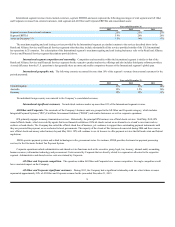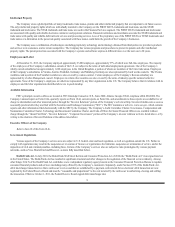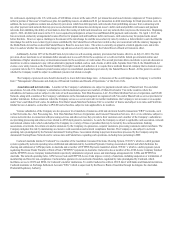First Data 2013 Annual Report Download - page 19
Download and view the complete annual report
Please find page 19 of the 2013 First Data annual report below. You can navigate through the pages in the report by either clicking on the pages listed below, or by using the keyword search tool below to find specific information within the annual report.
loss for the amount of the refund paid to the cardholder. The Company has an active program to manage its credit risk and often mitigates its risk by
obtaining collateral. Notwithstanding the Company’s program for managing its credit risk, it is possible that a default on such obligations by one or more of
the Company’s merchants could have a material adverse effect on the Company’s business.
The Company’s debt agreements contain restrictions that will limit the Company’s flexibility in operating its business.
The indentures governing the Company’s senior secured notes, senior unsecured notes, senior subordinated notes, the senior PIK notes of Holdings
and the credit agreement governing the senior secured credit facilities contain various covenants that limit the Company’s ability to engage in specified types of
transactions. These covenants limit the Company’s and its restricted subsidiaries’ ability to, among other things:
· incur additional indebtedness or issue certain preferred shares;
· pay dividends on, repurchase or make distributions in respect of the Company’s capital stock or make other restricted payments;
· make certain investments;
· sell certain assets;
· create liens;
· consolidate, merge, sell or otherwise dispose of all or substantially all of the Company’s assets;
· enter into certain transactions with the Company’s affiliates; and
· designate the Company’s subsidiaries as unrestricted subsidiaries.
A breach of any of these covenants could result in a default under one or more of these agreements, including as a result of cross default provisions and,
in the case of the revolving credit facilities, permit the lenders to cease making loans to the Company. Upon the occurrence of an event of default under the
Company’s senior secured credit facilities, the lenders could elect to declare all amounts outstanding under the Company’s senior secured credit facilities to be
immediately due and payable and terminate all commitments to extend further credit. Such actions by those lenders could cause cross defaults under the
Company’s other indebtedness. If the Company was unable to repay those amounts, the lenders under the Company’s senior secured credit facilities could
proceed against the collateral securing those facilities. The Company has pledged a significant portion of the Company’s assets as collateral under the
Company’s senior secured credit facilities. If the lenders under the senior secured credit facilities accelerate the repayment of borrowings, the Company may
not have sufficient assets to repay the Company’s senior secured credit facilities and senior secured notes, second lien notes, senior unsecured notes and senior
subordinated notes.
Acquisitions and integrating such acquisitions create certain risks and may affect the Company’s operating results.
The Company has been an active business acquirer and may continue to be active in the future. The acquisition and integration of businesses involves
a number of risks. The core risks are in the areas of valuation (negotiating a fair price for the business based on inherently limited diligence) and integration
(managing the complex process of integrating the acquired company’s people, products, technology and other assets so as to realize the projected value of the
acquired company and the synergies projected to be realized in connection with the acquisition).
In addition, international acquisitions often involve additional or increased risks including, for example:
· managing geographically separated organizations, systems and facilities;
· integrating personnel with diverse business backgrounds and organizational cultures;
· complying with foreign regulatory requirements;
· fluctuations in currency exchange rates;
· enforcement of intellectual property rights in some foreign countries;
· difficulty entering new foreign markets due to, among other things, customer acceptance and business knowledge of these new markets; and
· general economic and political conditions.
The process of integrating operations could cause an interruption of, or loss of momentum in, the activities of one or more of the Company’s combined
businesses and the possible loss of key personnel. The diversion of management’s attention and any delays or difficulties encountered in connection with
acquisitions and the integration of the two companies’ operations could have an adverse effect on the Company’s business, results of operations, financial
condition or prospects.
18
























